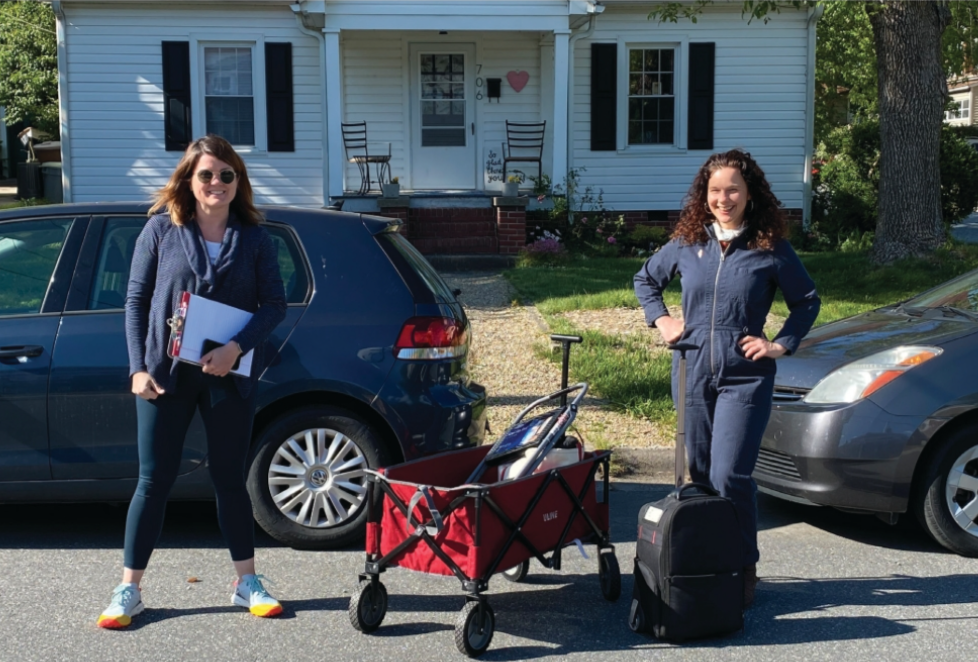Thompson, along with two others, produced an online book, “Westerwood in Quarantine,” featuring photographs and stories from fellow residents of the Westerwood neighborhood near downtown Greensboro.
COVID-19 restrictions were at their strictest in March and April, with many residents confined to their homes and rarely interacting with anyone outside of their households. While many struggled to adapt to the change, Cecelia Thompson ’05 saw an opportunity.
“I saw a trend on the national news of people doing porch portraits, and I thought it was a great idea,” said Thompson, who heads Action Greensboro, an economic nonprofit focused on improving the city’s quality of life.
Thompson partnered with her neighbor, photographer Betsy Blake, and the pair set out to capture residents of her neighborhood, Westerwood, in their yards. They originally had planned on donating the pictures to Greensboro History Museum, who had requested photos and stories to document people’s lives during the pandemic.
“We started walking from house to house and people were sharing these amazing stories,” said Thompson. “So, we followed up with the neighbors and asked them to submit journal entries.”
Thompson and Blake were joined by Anne Cassity, a graphic designer who also lived in Westerwood, and the three continued to document their community, which sits west of downtown Greensboro, during a critical historical event. Their work would culminate in an online book, “Westerwood in Quarantine.”
“Wouldn’t it be an amazing gift to the future if we documented firsthand experiences of this pandemic for neighbors that may live here when we’re not around anymore?” said Thompson, while explaining her vision for the project.
Thompson credited her inspiration for the photo journal to past snapshots of history. She recalls reading about the request that the National Office for History in the Netherlands put out for diaries written during World War II. The journals captured unique perspectives of life at the time.
Thompson explained that Westerwood was the perfect place to construct this journal. The neighborhood, which is celebrating its 101st year, was bustling with activity as neighbors took nightly strolls and spent time in their yards.
“The community was here for each other and we became tighter, sharing this experience together,” said Thompson. “I mean, when you’re isolated in your home, suddenly you have a lot more time to say hello to the folks across the street.”
Thompson, who is executive director of Action Greensboro, said that while the journal was not associated with her work for the nonprofit, she was able to use a lot of the tools that she practices every day at Action Greensboro.
“The project absolutely took on the spirit of Action Greensboro,” she explained. “It’s this idea of civic ownership, of asking ourselves how we can be innovative in bettering the community and bringing it together for the common good.”
The journal included stories and anecdotes from residents of Westerwood, including how their lives changed during the pandemic, and challenges that they were facing as a result of the stay-at-home order.

“Amy Vines completely forgot we were coming that day,” Thompson recalled from one of her visits. “So I asked her family to simply be their genuine selves, and the result was amazing. This wasn’t like a traditional magazine photoshoot; it’s finding people where they were in the moment.”
John Duberstein, who wrote in his journal entry that he was afraid that his sons were being deprived of their normal lives, challenged them to keep their world as broad as possible.
“He wanted to lift their gaze from their screens to the horizon,” said Thompson. “I think we all should remember to do that.”
The journal entries and photos were collected throughout the spring, at the beginning of the pandemic.

“I think if we asked the same questions a month later, the answers would have been different,” said Thompson, referring to the protests that began at the end of May. “The tone of the nation had completely changed.”
Thompson explained that the team struggled on how to address the lack of reference to the protests the followed the deaths of George Floyd, Breonna Taylor and others this summer. Cassity added a timeline in the front of the book, so that future generations would understand why the events of the summer weren’t mentioned.
“We’re only capturing a part of this year. People tend to think of historical events as just one moment in time,” said Thompson, referencing World War II and the Spanish Flu. “But especially since we’re living through one now, we’re recognizing how long they truly last.”
Thompson, Blake, and Cassity released their online book at the end of August, and as of now they have no intention of starting a new project.
“We’re just celebrating right now,” said Thompson. “We put in countless hours, so we’re just enjoying seeing other people enjoy it.”
The team hopes that their project inspires other communities and neighborhoods to document their experiences, and they would be more than willing to provide advice.
“I was a sociology major, and I was able to do what I did in school,” explained Thompson, while expressing her own appreciation for the journal. “This project gave me the opportunity to connect to humans and explore what it means to be human. I’m grateful for that.”



